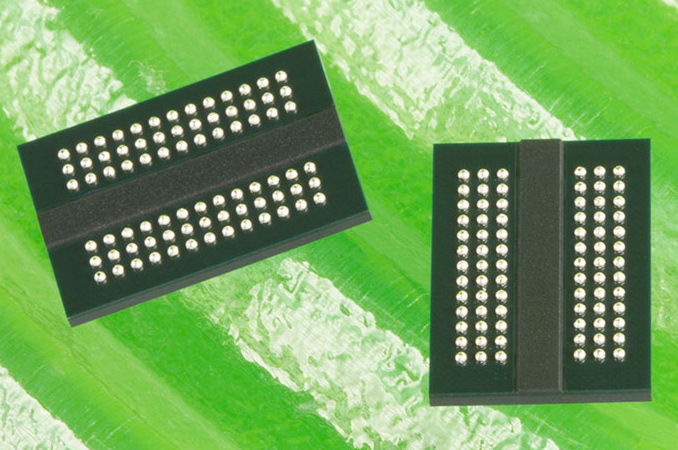Micron Expects to Debut GDDR7 Memory in 2024
by Anton Shilov on June 29, 2023 11:30 AM EST
Micron late on Wednesday revealed plans to introduce its first GDDR7 memory devices in the first half of 2024. The memory is expected to be used by next generation of graphics cards, and deliver performance that will be considerably higher than that of GDDR6 and GDDR6X.
"We plan to introduce our next-generation G7 product on our industry-leading 1ß node in the first half of calendar year 2024," said Sanjay Mehrotra, chief executive of Micron, as part of the company's earnings call.
Micron did not provide any additional specifics about its GDDR7 SGRAM devices that are set to be introduced in the first half of calendar 2024, though some general things about the technology have already been revealed by Cadence and Samsung in the recent months.
Samsung expects next generation GDDR to hit data transfer rates of 36 GT/s, though it's unclear whether they're talking about initial speeds for the new memory, some time later on. In any case, any increase over current 22 ~ 23 GT/s offered by GDDR6X will make the new type of memory more preferable for bandwidth-hungry devices like high-end graphics cards.
Meanwhile, Cadence has previously disclosed that GDDR7 will use PAM3 signaling, a three-level pulse amplitude modulation (which includes -1, 0, and +1 signaling levels), which allows it to transfer three bits of data over a span of two cycles. PAM3 provides a more efficient data transmission rate per cycle compared to two-level NRZ used by GDDR6, thereby reducing the need to upgrade to higher memory interface clocks and the subsequent signal loss challenges that this might cause. GDDR6X currently does something similar with PAM4 (four states), so GDDR7 will be a bit different still. PAM3 ultimately transmits a bit less data per clock edge (1.5 bits vs. 2 bits), but it trades off with less stringent signal-to-noise ratio requirements.
While Micron plans to introduce its first GDDR7 product in the first half of 2024, an official launch of a new memory device indicates conclusion of its development and not its immediate use in commercial products. As GDDR7 employs a new encoding mechanism, it requires brand-new new memory controllers, and hence, graphics processors. While it is reasonable to anticipate AMD, Intel, and NVIDIA to introduce their next generation GPUs in the 2024 – 2025 timeframe, the exact timing of these graphics processor releases remains completely unclear.
For now, Cadence has GDDR7 verification solution for chip designers that need to ensure that their controllers and PHY are compliant with the upcoming specification while they finalize design of their GPUs and other processors.
Source: Micron










12 Comments
View All Comments
ballsystemlord - Thursday, June 29, 2023 - link
If it doesn't transfer 2 bits per clock then it's not DDR RAM (Double Data Rate).Yojimbo - Thursday, June 29, 2023 - link
I believe the article is imprecise. It should read that GDDR6X transmits 2 bits per clock edge and GDDR7 transmits 1.5 bits per clock edge, rather than bits per clock. Both standards are DDR as they both transmit on both the rising and falling edges of the clock cycle.Ryan Smith - Thursday, June 29, 2023 - link
This is correct; it was meant to be a discussion on clock edges. I've updated the article to clarify.Zoolook - Tuesday, July 11, 2023 - link
This sentence in the 5th paragraph should be updated as well, "which allows it to transfer three bits of data over a span of two cycles."Two cycles would be four edges and thus 6 bits.
nandnandnand - Thursday, June 29, 2023 - link
I'd like to see HBM become standard in consumer products. I also want a free pony and no more existential dread.Kurosaki - Thursday, June 29, 2023 - link
It was for a period... I have owned a hbm card, was top tier and I costed me 300usd new from the store.This gddr7 tech, you know what it will do right? Make Nvidia and AMD to lower their bus width to 96 bits and maintain performance while gouging the price a bit more. The next 5060 will perform worse than the by then very old 2060 and cost twice as much.
Just guessing here based on previous 8 years of gpu development...
GreenReaper - Thursday, June 29, 2023 - link
But think of the power efficiency!sheh - Thursday, June 29, 2023 - link
The 4060 is 50% faster than he 2060, and with 33% more RAM:https://www.techpowerup.com/review/galax-geforce-r...
The 5060 isn't likely to be slower.
StevoLincolnite - Saturday, July 1, 2023 - link
The 2070 released in 2018. It's 5 years old and the 4060 is what... 10-20% faster? What a joke.sonny73n - Monday, July 3, 2023 - link
https://m.youtube.com/watch?v=WLk8xzePDg8I completely agree with Kurosaki.